2015 AUDI Q5 light
[x] Cancel search: lightPage 173 of 302
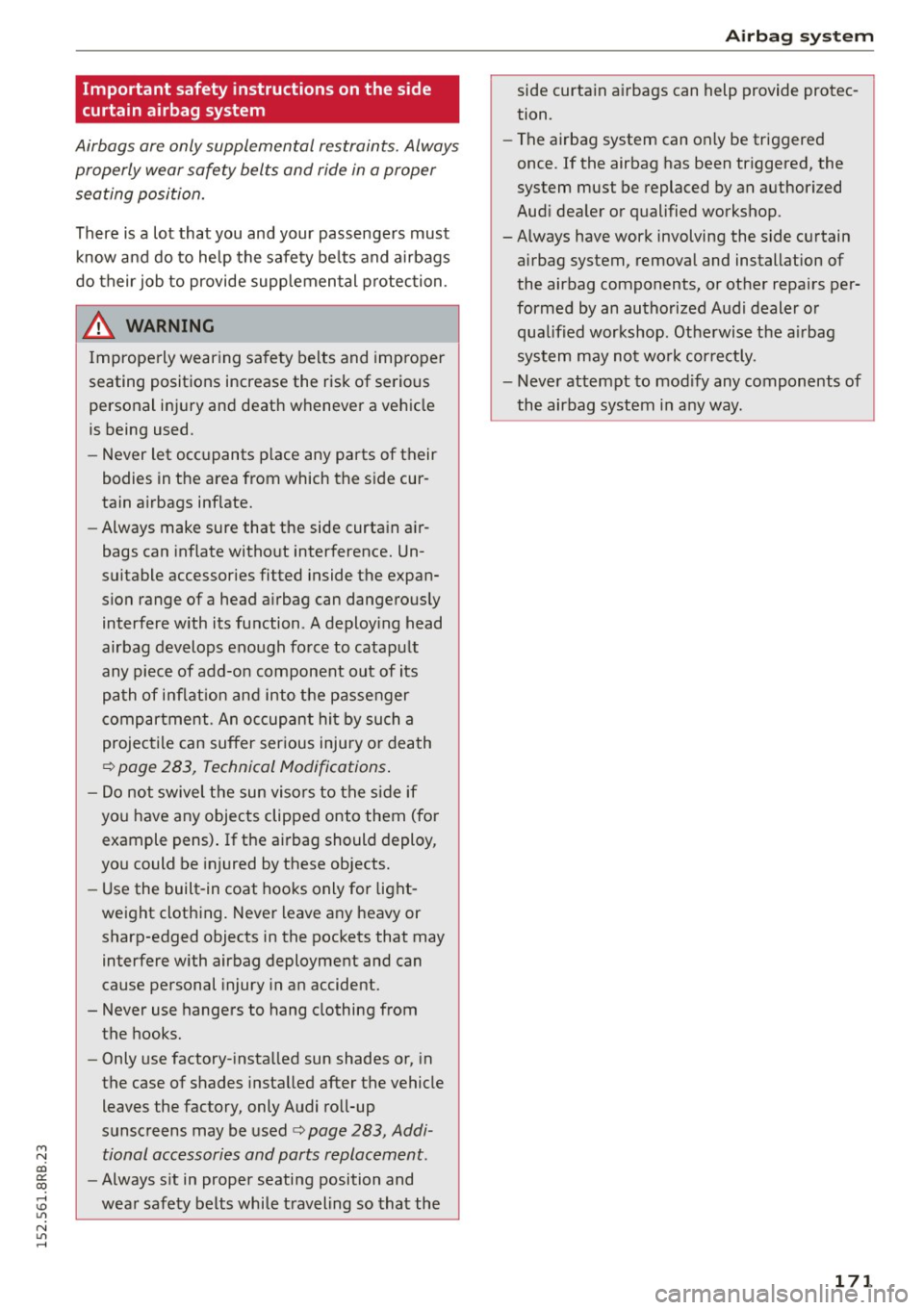
M N
co
a:
co
,...., \!) 1.1"1
N 1.1"1 ,....,
Important safety instructions on the side
curtain airbag system
Airbags are only supplemental restraints. Always
properly wear safety belts and ride in a proper
seating position.
There is a lot that you and your passengers must
know and do to help the safety belts and airbags
do their job to provide supplemental protection.
& WARNING
-
Improperly wearing safety belts and improper
seating positions increase the risk of serious
personal injury and death whenever a vehicle
is being used.
- Never let occupants place any parts of their
bodies in the area from which the side cur
tain airbags inflate.
- Always make sure that the side curtain air
bags can inflate without interference. Un
suitable accessories fitted inside the expan
sion range of a head airbag can dangerously
interfere with its function. A deploying head
airbag develops enough force to catapult
any piece of add-on component out of its
path of inflation and into the passenger
compartment. An occupant hit by such a
projectile can suffer serious injury or death
¢ page 283, Technical Modifications.
- Do not swivel the sun visors to the side if
you have any objects clipped onto them (for
example pens). If the airbag should deploy,
you could be injured by these objects.
- Use the built-in coat hooks only for light
weight clothing. Never leave any heavy or
sharp-edged objects in the pockets that may
interfere with airbag deployment and can
cause personal injury in an accident.
- Never use hangers to hang clothing from the hooks.
- Only use factory-installed sun shades or, in
the case of shades installed after the vehicle
leaves the factory, only Audi roll-up
sunscreens may be used
¢ page 283, Addi
tional accessories and parts replacement.
- Always sit in proper seating position and
wear safety belts while traveling so that the
Airbag system
side curtain airbags can help provide protec
tion.
- The airbag system can only be triggered
once. If the airbag has been triggered, the
system must be replaced by an authorized
Audi dealer or qualified workshop.
- Always have work involving the side curtain
airbag system, removal and installation of
the airbag components, or other repairs per
formed by an authorized Audi dealer or
qualified workshop. Otherwise the airbag
system may not work correctly.
- Never attempt to modify any components of
the airbag system in any way.
171
Page 175 of 302

M N
co
a:
co
,...., \!) ..,.,
N ..,., ,....,
exceptional circumstances and the
PASSENGER AIR BAG OFF light does not
come on and stay on, immediately install
the rear-facing child safety seat in a rear
seating position and have the airbag system
inspected immediately by your Audi dealer .
A WARNING
If, in exceptional circumstances, you must in
stall a forward-facing child restraint on the
front passenger's seat:
- Always make sure the forward-facing seat
has been designed and certified by its man
ufacturer for use on a front seat with a pas
senger front and side airbag.
- Always follow the manufacturer's instruc
tions provided with the child safety seat or
carrier.
- Always move the passenger seat into its
rearmost position in the seat's fore and aft
adjustment range, as far away from the air
bag as possible before installing the child
restraint. The backrest must be adjusted to
an upright position.
- Always make sure that the
PASSENGER AIR
BAG OFF
light comes on and stays on all the
time whenever the ignition is switched on.
(D Tips
Always replace child restraints that were in
stalled in a vehicle during a crash. Damage to
a child restraint that is not visible could cause
it to fail in another collision situation.
Advanced front airbag system and children
Your vehicle is equipped with a front "Advanced
Airbag System " in compliance with United States
Federal Motor Vehicle Safety Standard (FMVSS)
208 as applicable at the time your vehicle was
manufactured.
The Advanced Airbag system in your vehicle has
been certified to meet the "low-risk" require
ments for 3- and 6-year old children on the pas
senger side and small adults on the driver side.
The low risk deployment criteria are intended to
reduce the risk of injury through interaction with
Child safety
the airbag that can occur, for example, by being
too close to the steering wheel and instrument
panel when the airbag inflates. In addition, the
system has been certified to comply with the "suppression" requirements of the Safety Stand
ard, to turn off the front airbag for infants up to 12 months who are restrained on the front pas
senger seat in child restraints that are listed in
the Standard.
Even though your vehicle is equipped with an Ad
vanced Airbag system, all children, especially
those 12 years and younger, should always ride in
the back seat properly restrained for their age
and size . The airbag on the passenger side makes
the front seat a potentially dangerous place for a child to ride. The front seat is not the safest place
for a child in a forward-facing child safety seat. It can be a very dangerous place for an infant or a
larger child in a rearward-facing seat.
Advanced Airbags and the weight-sensing mat in the front seat
The Advanced Airbag System in your vehicle de
tects the presence of an infant or child in a child
restraint on the front passenger seat using the
weight-sensing mat in the seat cushion and the
sensor below the safety belt latch on the front
passenger seat that measures the tension on the
safety belt .
The weight-sensing mat measures total weight of
the child and the child safety seat and a child blanket on the front passenger seat. The weight
on the front passenger seat is related to the de
sign of the child restraint and its "footprint", the
size and shape of the bottom of the child re straint as it sits on the seat . The weight of a child
restraint and its "footprint" vary for different
kinds of child restraints and for the different
models of the same kind of child restraint offered
by child restraint manufacturers.
The weight ranges for the individual types, makes
and models of child restraints that the NHTSA
has specified in the Safety Standard together
with the weight ranges of typical infants and typ
ical 1 year-old child have been stored in the con
trol unit of the Advanced Airbag System. When a
1iJ11-
173
Page 177 of 302
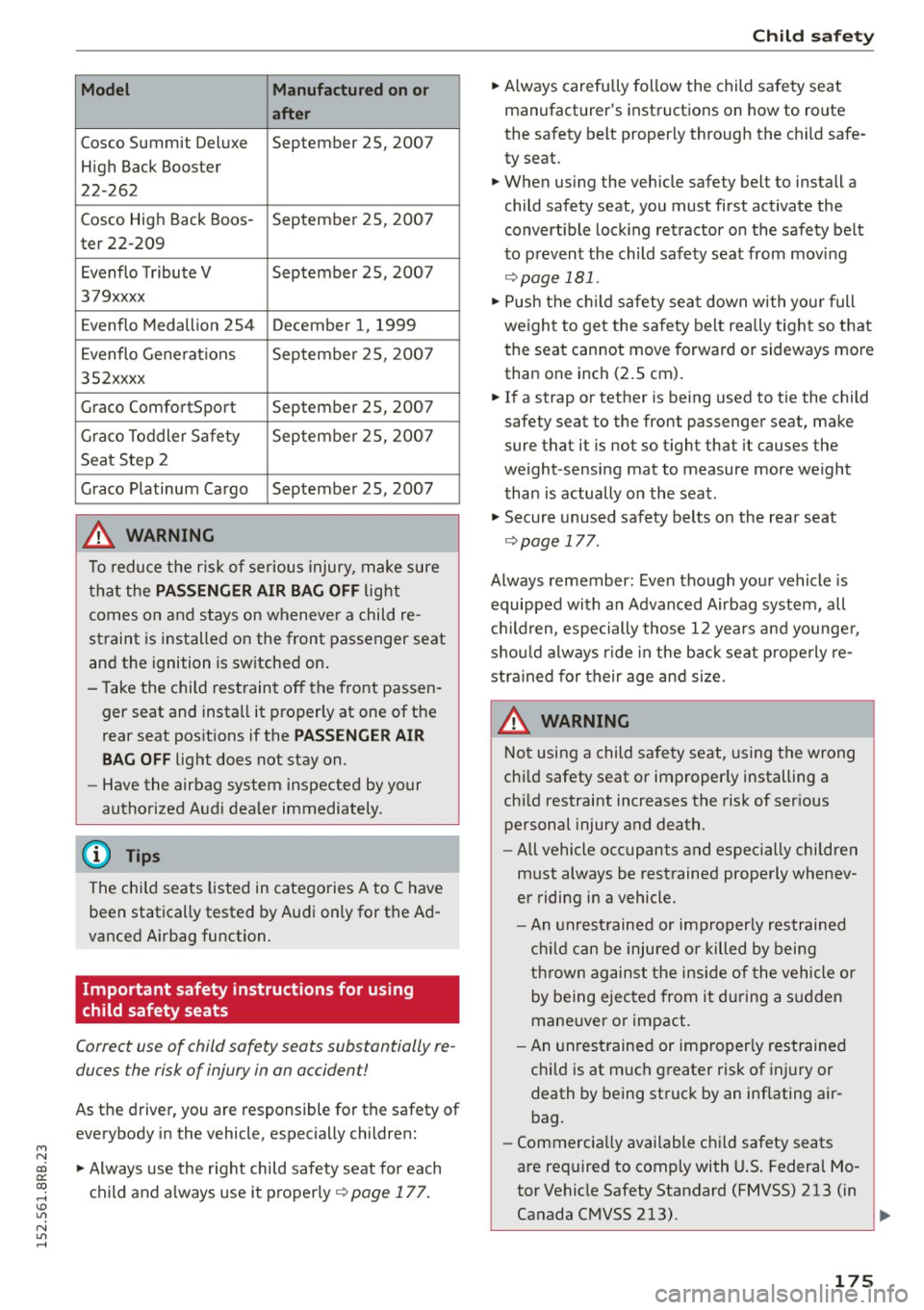
M N
co
a:
co
,...., \!) 1.1'1
N 1.1'1 ,....,
Model Manufactured on or
a fter
Cosco Summit Deluxe September 25, 2007
High Back Booster
22-262
Cosco High Back Boos -September 25, 2007
ter 22-209
Evenflo Tribute V September 25, 2007
379xxxx
Evenflo Medallion 254 December 1, 1999
Evenflo Generations September 25, 2007
3S2xxxx
Graco ComfortSport September 25, 2007
Graco Toddler Safety September 25, 2007
Seat Step 2
Graco Platinum Cargo September 25, 2007
.&, WARNING
To reduce the risk of serious injury, make sure
that the
PASS ENGER AIR BAG OFF light
comes on and stays on whenever a child re
straint is installed on the front passenger seat
and the ignition is switched on.
- Take the child restraint off the front passen ger seat and install it properly at one of the
rear seat positions if the
PASSENGER AIR
BA G OFF
light does not stay on.
- Have the airbag system inspected by your
authorized Audi dealer immediately.
(D Tips
The ch ild seats listed in categories A to C have
been statically tested by Audi on ly for the Ad
vanced Airbag function.
Important safety instructions for using
child safety seats
Correct use of child safety seats substantially re
duces the risk of injury in an accident!
As the driver, you are responsible for the safety of
everybody in the vehicle, especially children:
.,. Always use the right child safe ty seat for each
child and a lways use it properly ¢
page 177.
Child sa fety
.,. Always carefully follow the child safety seat
manufacturer's instructio ns on how to route
the safety belt properly through the child safe
ty seat.
.,. When using the vehicle safety belt to install a
child safety seat, you must first activate the
convert ible lock ing retractor on the safety belt
to prevent the child safety seat from mov ing
r::) page 181 .
.,. Push the ch ild safety sea t down with yo ur full
weight to get the safety belt rea lly tight so that
the seat cannot move forward or sideways more
than one inch (2.5 cm).
.,. If a strap or tether is being used to tie the child
safety seat to the front passenger seat, make
sure that it is not so tight that it causes the
weight -sensing mat to measure more we ight
than is actually on the seat .
.,. Secure unused safety belts on the rear seat
r::) page 177 .
Always remember : Even though your vehicle is
equipped with an Advanced Airbag system, all
c hi ld ren, especially those 12 years and younge r,
shou ld a lways r ide in the back seat prope rly re
stra ined for their age and size.
A WARNING
=
Not using a child sa fety seat, us ing the wrong
chi ld safety seat or improperly installing a
chi ld restraint increases the risk of serious
personal injury and death.
- All vehicle occ upants and especially children
must always be restrained properly whenev
er riding in a vehicle .
- An unrest rained or improperly restrained
ch ild can be injured or killed by being
thrown against the ins ide of the vehicle o r
b y being ejected from it du ring a s udden
maneuver or impact.
- An unrestrained or improperly res trained
child is at much greater risk of injury or
death by being struck by an inflating air
bag.
- Commercia lly available child safety seats
are req uired to comply with U.S. Federa l Mo
tor Vehicle Safety Standard (FMVSS) 213 (in
Canada CMVSS 213). .,_
175
Page 179 of 302
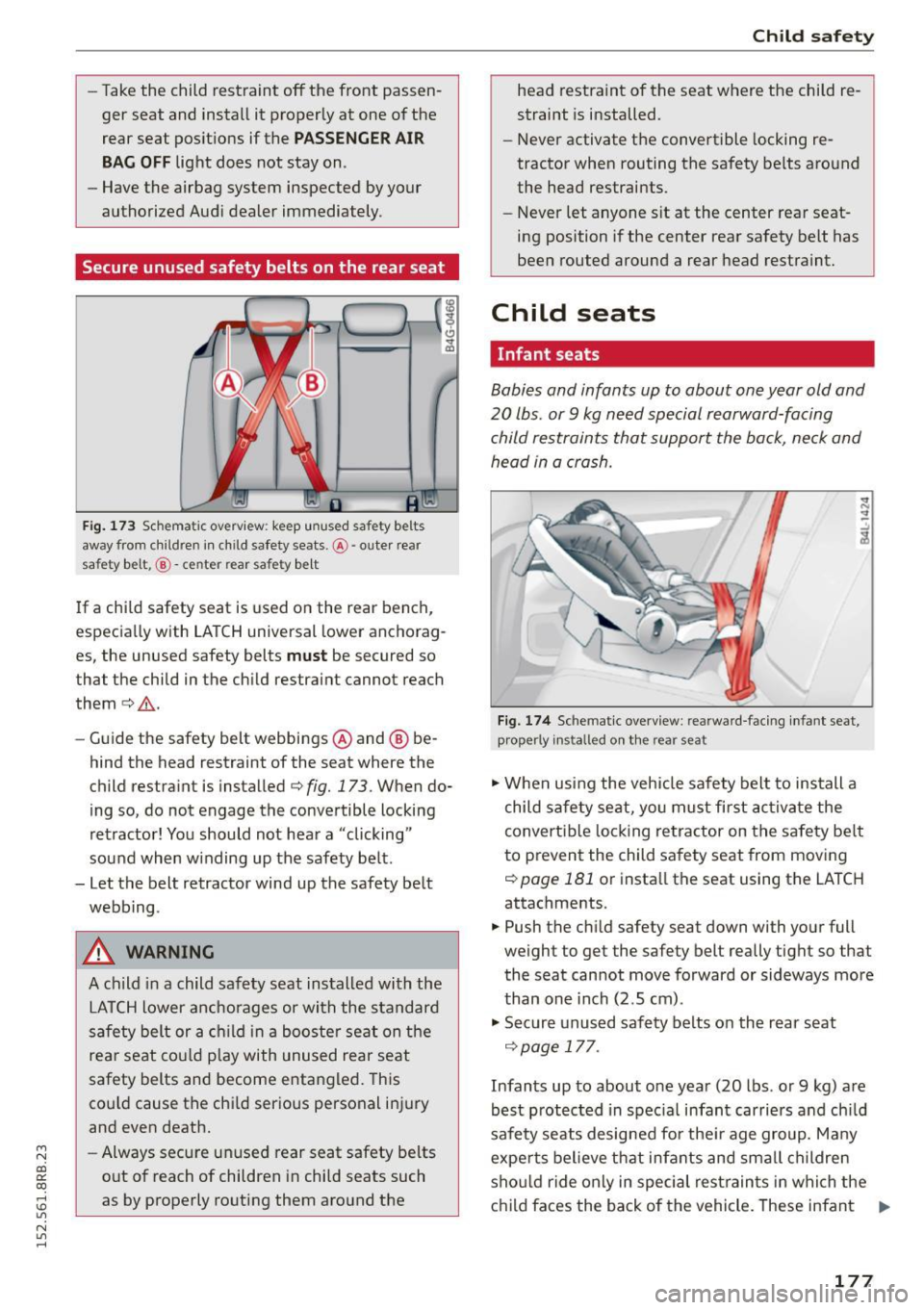
M N
co ~ co
rl I.O
"' N
"' rl
-Take the child restraint off the front passen
ger seat and install it properly at one of the
rear seat pos itions if the
PASSENGER AIR
BA G OFF
light does not stay on.
- Have the airbag system inspected by your
authorized Audi dealer immediately.
Secure unused safety belts on the rear seat
Fig . 173 Schematic overview: keep unused safety belts
away from children in child safety seats. @-oute r rear
safety belt,
@ -center rea r safety belt
If a chi ld safety seat is used on the rear bench ,
especia lly with LATCH universal lower anchorag
es, the unused safety belts
must be secured so
that the child in the child restraint cannot reach
them¢ _&.
- Guide the safety belt webbings @and @ be
hind the head restraint of the seat where the
child restraint is installed¢
fig. 173. When do
ing so, do not engage the convertible locking
retractor! You should not hear a "clicking"
sound when w inding up the safety belt.
- Let the belt retractor wind up the safety belt
webbing .
A WARNING
A child in a child safety seat installed with the
LA TCH lower anchorages or with the standard
safety belt or a ch ild i n a booste r seat on the
rea r seat co uld play with unused rear seat
safety belts and become entangled. This
co uld cause the chi ld serious personal inj ury
and even death.
- Always secure un used rear seat safety belts
o ut of reach of children in child seats such
as by properly routing them around the
Chil d sa fe ty
head restra int of the seat where the child re
straint is installed.
- Never activate the convertible locking re
tractor when routing the safety belts around
the head restraints.
- Never let anyone s it at the center rear seat
ing position if the center rear safety belt has
been routed around a rear head restraint.
Child seats
Infant seats
Babies and infants up to about one year old and
20 lbs . or
9 kg need special rearward-facing
child restraints that support the back, neck and
head in a crash.
F ig. 174 Schemat ic overv iew : rearward -fac ing infant seat,
proper ly installed on th e rear seat
., W hen using the vehicle safety belt to install a
child safe ty seat, yo u must first ac tivate the
convert ib le lock ing retractor on the safety be lt
to prevent the child sa fety seat from mov ing
i=:> page 181 or insta ll the seat using the LATCH
attachments.
.. Push the child safety seat down with your full
weight to get the safety belt really tight so that
the seat cannot move forward or sideways more
than one inch (2.5 cm).
., Secure unused safety belts on the rear seat
¢page 177.
Infants up to about one year (20 lbs. or 9 kg) are
best p rotected in spec ial infant carriers and ch ild
safety seats designed for the ir age group. Many
expe rts bel ieve that infants and sma ll children
sho uld ride only in special restrain ts in which the
child faces the back of the vehicle. These infant .,.
177
Page 180 of 302
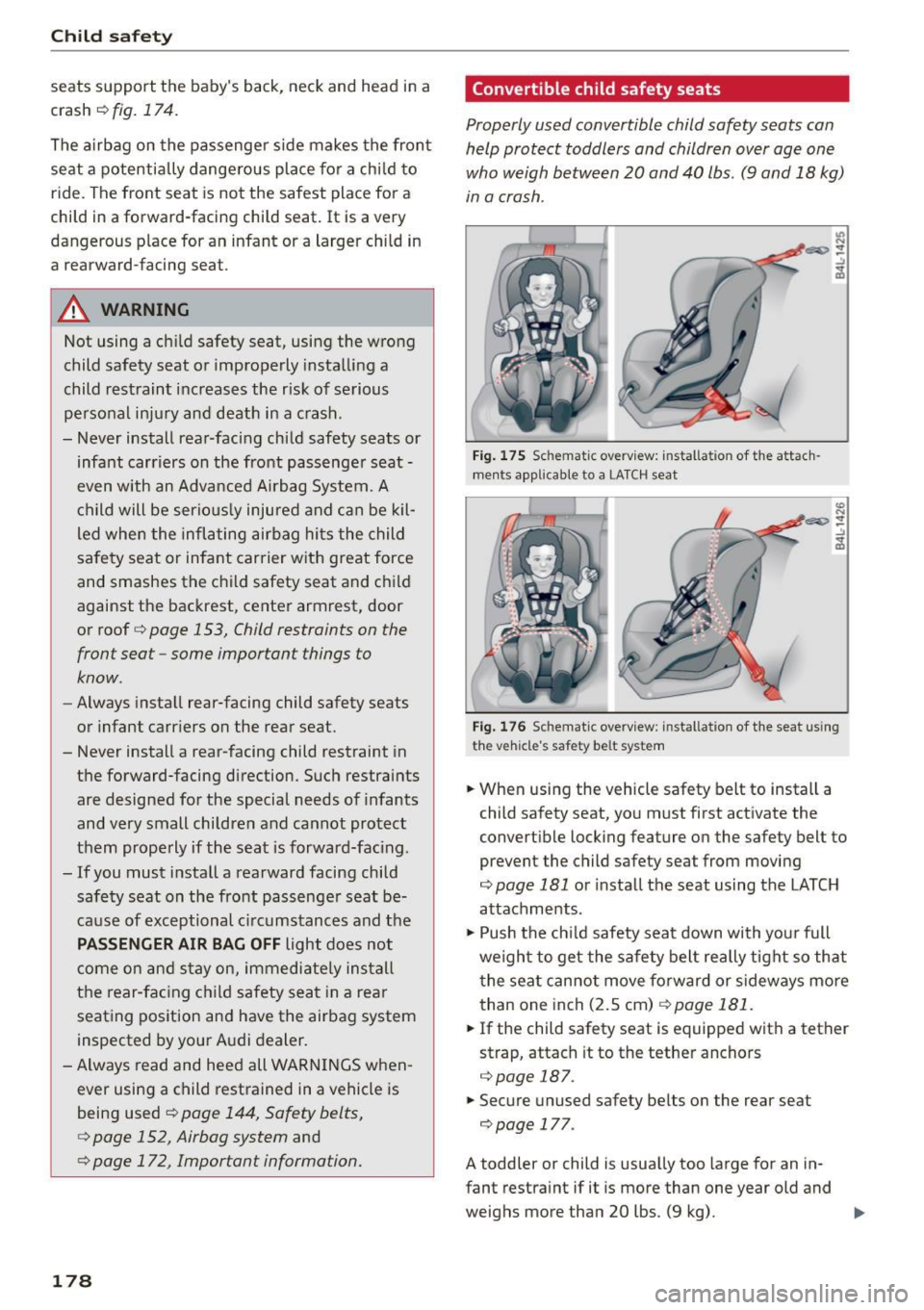
Child safety
seats support t he baby 's back, neck and head in a
crash
r=> fig . 174.
The airbag on the passenger side makes the fron t
seat a potentially dange rous place for a ch ild to
ride. The front seat is not the safest place for a
child in a fo rward-facing child seat. It is a very
dangerous p lace for an infant or a larger chi ld in
a rearward-facing seat .
_&. WARNING
Not using a child safety seat , using the wrong
child safety seat o r imp roperly insta lling a
child restraint inc reases the r isk of serious
personal in ju ry and death in a crash .
- Never install rea r-facing ch ild safety seats or
infant carriers on the front passenger seat -
even w ith an Advanced Ai rbag System. A
c hild will be serio us ly injured and c an be kil
led whe n the infl ating airbag hits the child
sa fe ty seat or infant carrier w ith great force
and smashes the c hild safety seat and c hild
against the bac krest, center armrest, door
or roof
r=> page 153, Child restraints on the
front seat -some important things to
know .
-Always insta ll rear-facing child safety seats
o r infant ca rr iers on the rear seat.
- Never install a rear-facing child restraint in the forward-facing direction. Such restra ints
are designed for the specia l needs of infants
and very small children and cannot protect
them prope rly if the seat is forward-fac ing .
- If you must install a rearward facing child safety seat on the front pass enge r seat be
ca use of exceptional c ircumstanc es and t he
PASSENGER AIR BAG OFF light does not
c ome on an d st ay on, immedi ate ly ins tall
t h e rear-facing c hild safety sea t in a rea r
seat ing position and have the airbag system
inspected by your Audi dealer.
- Alw ays read and hee d all WARN INGS when
ever using a child restrained in a vehicle is
being used
c::> page 144 , Safety belts,
c::> page 152, Airbag system
and
c::> page 172, Important information.
178
Convertible child safety seats
Properly used convertible child safety seats can
help protect toddlers and children over age one
who weigh between 20 and 40 lbs. (9 and 18 kg)
in a cra sh .
Fi g. 175 Sc hem at ic ove rv iew: instal la ti on of t he attach
m ents applicable to a LA T CH seat
Fi g. 1 76 Schemat ic ove rv iew : in stal lat io n of th e seat usin g
the v ehicl e's sa fet y bel t system
.. When using the vehicle safety belt to install a
child sa fety seat, you must first activate the
convertible locking feature on the safety belt to
prevent the child safety seat from moving
r=> page 181 or i nsta ll the seat using the LATC H
attachments.
.,. Push the ch ild safety seat down with you r full
weigh t to get the safe ty belt rea lly tight so that
t he sea t ca nnot move forward or sideways mo re
than one inch (2.5 cm)
r=> page 181.
.. If the child safety seat is equipped with a tether
strap, attach it to the tether anchors
c::> page 187.
.. Secure unused safety belts on the rear seat
r=> page 177 .
A toddler or child is usua lly too large for an in
fant restra int if it is more than one year old and
weighs more than 20 lbs . (9 kg) .
IJJ,,
Page 181 of 302
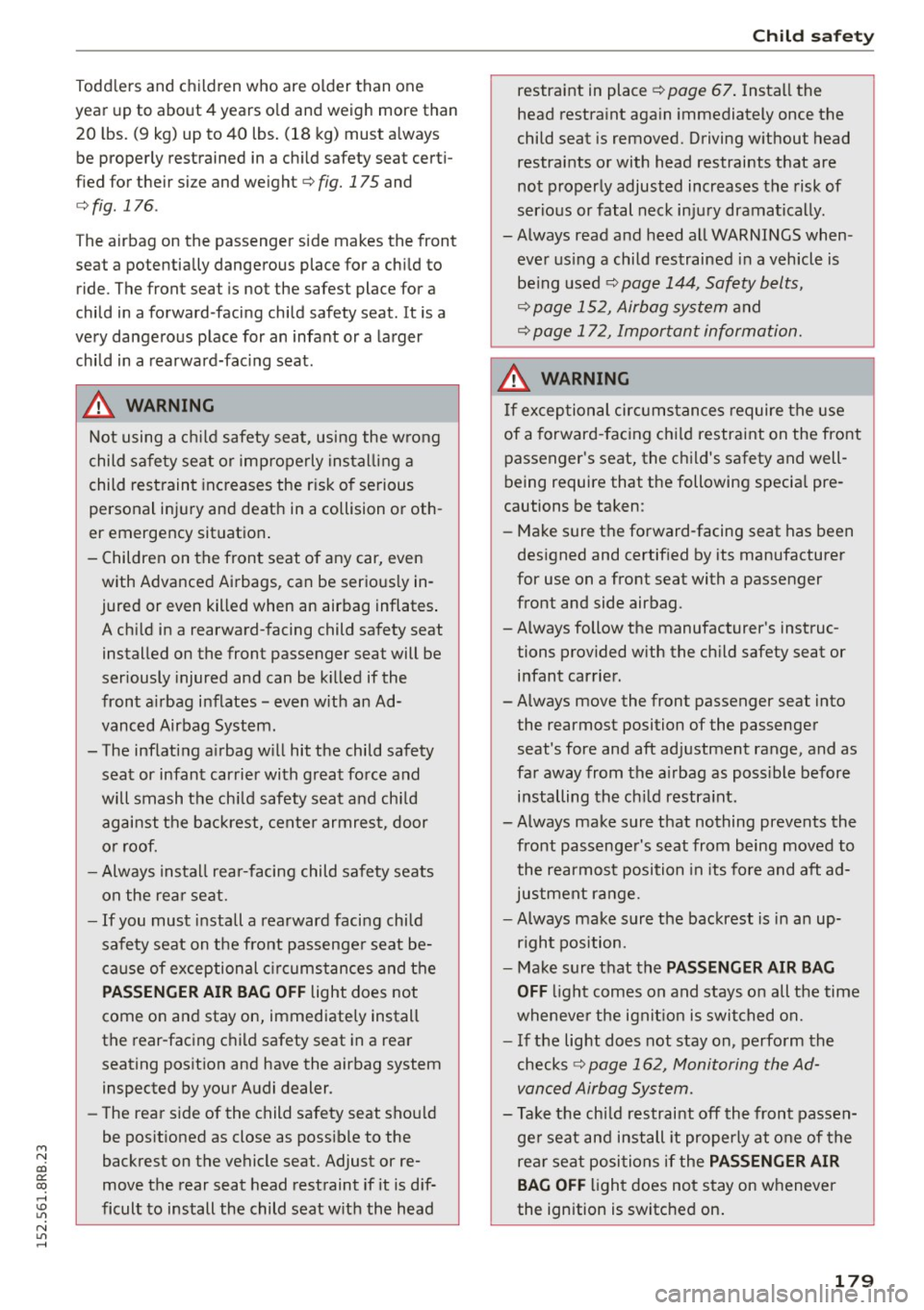
M N
co
a:
co
,...., \!) 1.1'1
N 1.1'1 ,....,
Toddlers and children who are older than one
year up to about 4 years old and weigh more than
20 lbs. (9 kg) up to 40 lbs. (18 kg) must always
be properly restrained in a child safety seat certi
fied for their si ze and weight¢
fig. 175 and
¢fig. 176 .
The airbag on the passenger side makes the front
seat a potentially dangerous place for a child to ride . The front seat is not the safest place for a
child in a forward-facing child safety seat. It is a
very dangerous place for an infant or a larger
child in a rearward-facing seat.
.8, WARNING
Not using a child safety seat, using the wrong
child safety seat or improperly installing a
child restraint increases the risk of serious
personal injury and death in a collision or oth
er emergency situation.
- Children on the front seat of any car, even
with Advanced Airbags, can be seriously in
jured or even killed when an airbag inflates. A child in a rearward-facing child safety seat
installed on the front passenger seat will be
seriously injured and can be killed if the
front airbag inflates -even with an Ad·
vanced Airbag System .
- The inflating airbag will hit the child safety seat or infant carrier with great force and
will smash the child safety seat and child against the backrest, center armrest, door
or roof.
- Always install rear-facing child safety seats
on the rear seat.
- If you must install a rearward facing child
safety seat on the front passenger seat be
cause of exceptional circumstances and the
PASSENGER AIR BAG OFF light does not
come on and stay on, immediately install
the rear-facing child safety seat in a rear
seating position and have the airbag system inspected by your Audi dealer.
- The rear side of the child safety seat should
be positioned as close as possible to the
backrest on the vehicle seat. Adjust or re
move the rear seat head restraint if it is dif
ficult to install the child seat with the head
Child safety
restraint in place ¢page 67. Install the
head restraint again immediately once the
child seat is removed. Driving without head restraints or with head restraints that are
not properly adjusted increases the risk of
serious or fatal neck injury dramatically.
- Always read and heed all WARNINGS when
ever using a child restrained in a vehicle is
being used¢
page 144, Safety belts,
¢ page 152, Airbag system
and
¢ page 172, Important information.
.8, WARNING
If exceptional circumstances require the use
of a forward-facing child restraint on the front
passenger's seat, the child's safety and well
being require that the following special pre
cautions be taken:
- Make sure the forward-facing seat has been
designed and certified by its manufacturer
for use on a front seat with a passenger
front and side airbag .
- Always follow the manufacturer's instruc
tions provided with the child safety seat or
infant carrier.
-Always move the front passenger seat into the rearmost position of the passenger seat's fore and aft adjustment range, and as
far away from the airbag as possible before installing the child restraint.
- Always make sure that nothing prevents the
front passenger's seat from being moved to the rearmost position in its fore and aft ad
justment range.
- Always make sure the backrest is in an up
right position.
- Make sure that the
PASSENGER AIR BAG
OFF
light comes on and stays on all the time
whenever the ignition is switched on.
- If the light does not stay on, perform the
checks ¢
page 162, Monitoring the Ad
vanced Airbag System.
- Take the child restraint off the front passen
ger seat and install it properly at one of the
rear seat positions if the
PASSENGER AIR
BAG OFF
light does not stay on whenever
the ignition is switched on.
179
Page 183 of 302
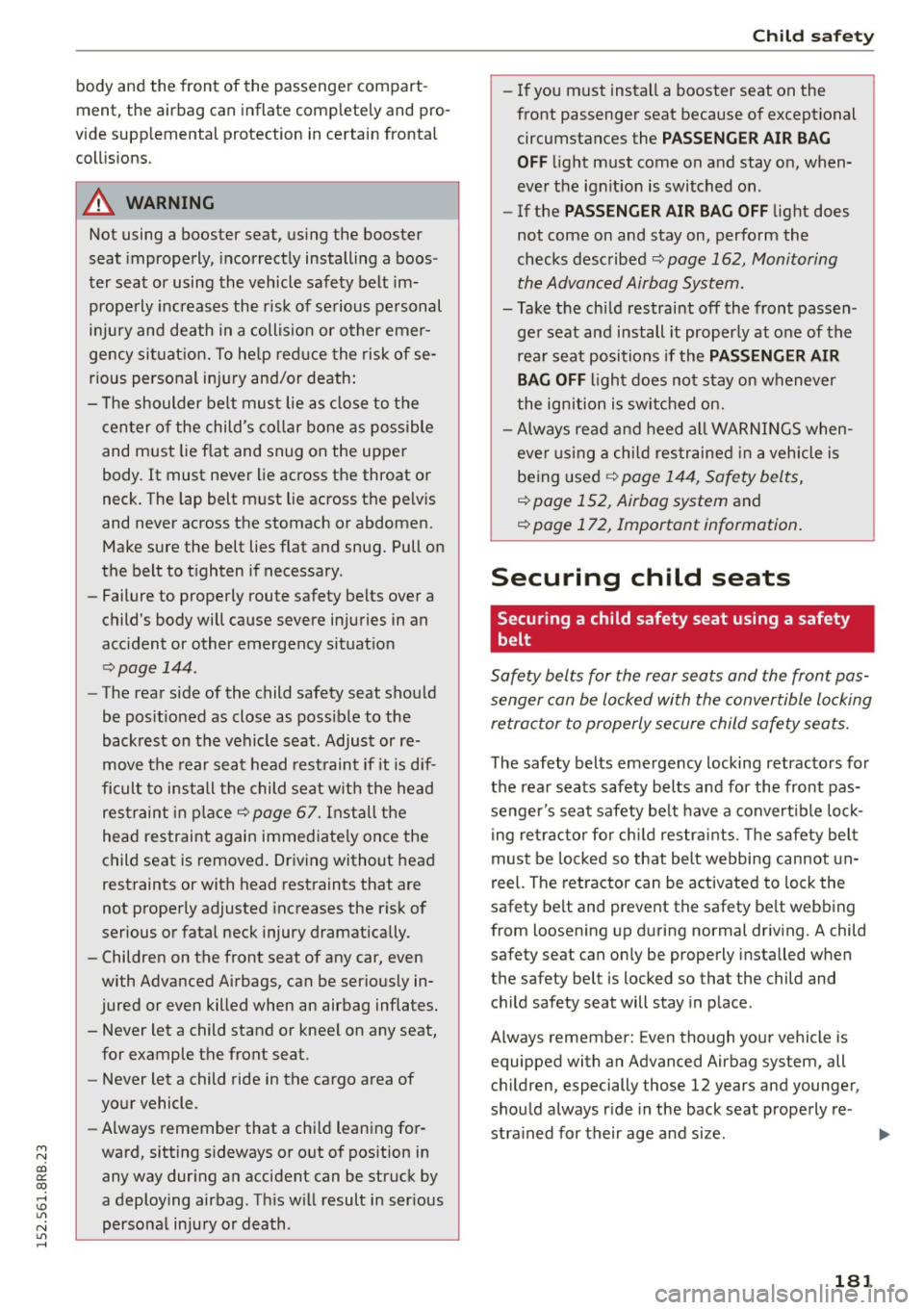
M N
co
a:
co
,...., \!) ..,.,
N ..,., ,....,
body and the front of the passenger compart
ment, the airbag can inflate comp letely and pro
vide supp lemental protection in certain frontal
coll is ions .
& WARNING
Not using a booster seat, us ing the booster
seat imprope rly, incorrect ly installing a boos
ter seat or using the vehicle safety belt im prope rly increases the r isk of se rious personal
injury and death in a collision or other emer
gency sit uat ion. To he lp reduce the risk of se
r ious personal inju ry and/or death:
- T he shoulder be lt mus t lie as close to the
c en ter o f the child's co llar bone as possible
and must lie f lat and snug on the uppe r
body.
It must never lie across the throat o r
neck . The lap belt m ust lie across the pelv is
and never across the stomach or abdomen.
Make sure the belt lies flat and snug. Pull on
the belt to t ighten if necessary.
- Failure to properly route safety belts over a
child's body will cause severe in juries in an
acc ident or other emergency situat ion
~ page 144.
-The rea r side of the child safety seat shou ld
be pos it ioned as close as poss ible to the
backrest on the vehicle seat . Adjust or re
move the rear seat head rest raint if it is d if
ficult to install the child seat w ith the he ad
res traint in p lace
~ page 67. Inst all the
head restraint again immed iate ly once the
child seat is removed . Dr iv ing without head
restraints or with head rest raints that are
not prope rly adjusted inc reases the r isk o f
serious or fatal neck injury dramatically.
- Children on the front seat of any car, even
with Advanced Airbags, can be ser ious ly in
jured or even killed when an airbag inflates.
- Never let a child stand or knee l on any seat,
for example the front seat.
- Never let a child ride in the cargo area of
yo ur vehicle.
- Always remember that a chi ld lean ing fo r
ward, sitting s ideways or o ut o f pos ition in
any way dur ing an accident can be struck by
a deploying airbag. Th is w ill result in ser ious
persona l inju ry or death .
Child sa fety
- If you must install a booster seat on the
front passenge r seat because o f exceptional
circumstances the
PASSENGER AIR BAG
OFF
li ght must come on and stay on, when
eve r the ignit ion is switched o n.
- If the
PASSENGER AIR BAG OFF light does
not come on and stay on, perform the
checks desc ribed
~ page 162, Monitoring
th e Advanc ed Airbag System.
- Take t he chi ld restraint off the fron t passen
ge r seat and install it properly at one of the
rea r seat posi tions if the
PASSENGER AIR
BAG OFF
ligh t does n ot stay on whenever
the igni tion is switched on.
- Always read and heed al l WARN IN GS when
eve r using a child res tra ine d in a vehicle is
be ing used ¢
page 1 44, Safety belts,
¢ page 152, Airbag system and
¢ page 172, Important information .
Securing child seats
Securing a child safety seat using a safety
belt
Safety belts for the rear seats and the front pas
senger can be lock ed with th e conv ertible locking
retrac tor to properly secure child safety seats.
The safety belts emergency locking retracto rs fo r
the rea r seats safety belts an d for the front pas
senger 's seat safety be lt have a convert ible lo ck
i ng re tr acto r fo r child restr aints. The safety be lt
must be loc ked so that belt webbing cannot un
reel. The ret ractor can be activated to lock the
safety belt and prevent the safety be lt webb ing
from loosen ing up d uring normal driv ing. A child
safety seat can on ly be properly installed when
the safety belt is locked so that the child and c h ild safety seat will stay in p lace .
Always remember: Even tho ugh your vehicle is
equipped with an Advanced Airbag system, all
c hi ldren, especially those 12 years and younge r,
shou ld always r ide in the back seat prope rly re
stra ined for their age and size.
181
Page 184 of 302
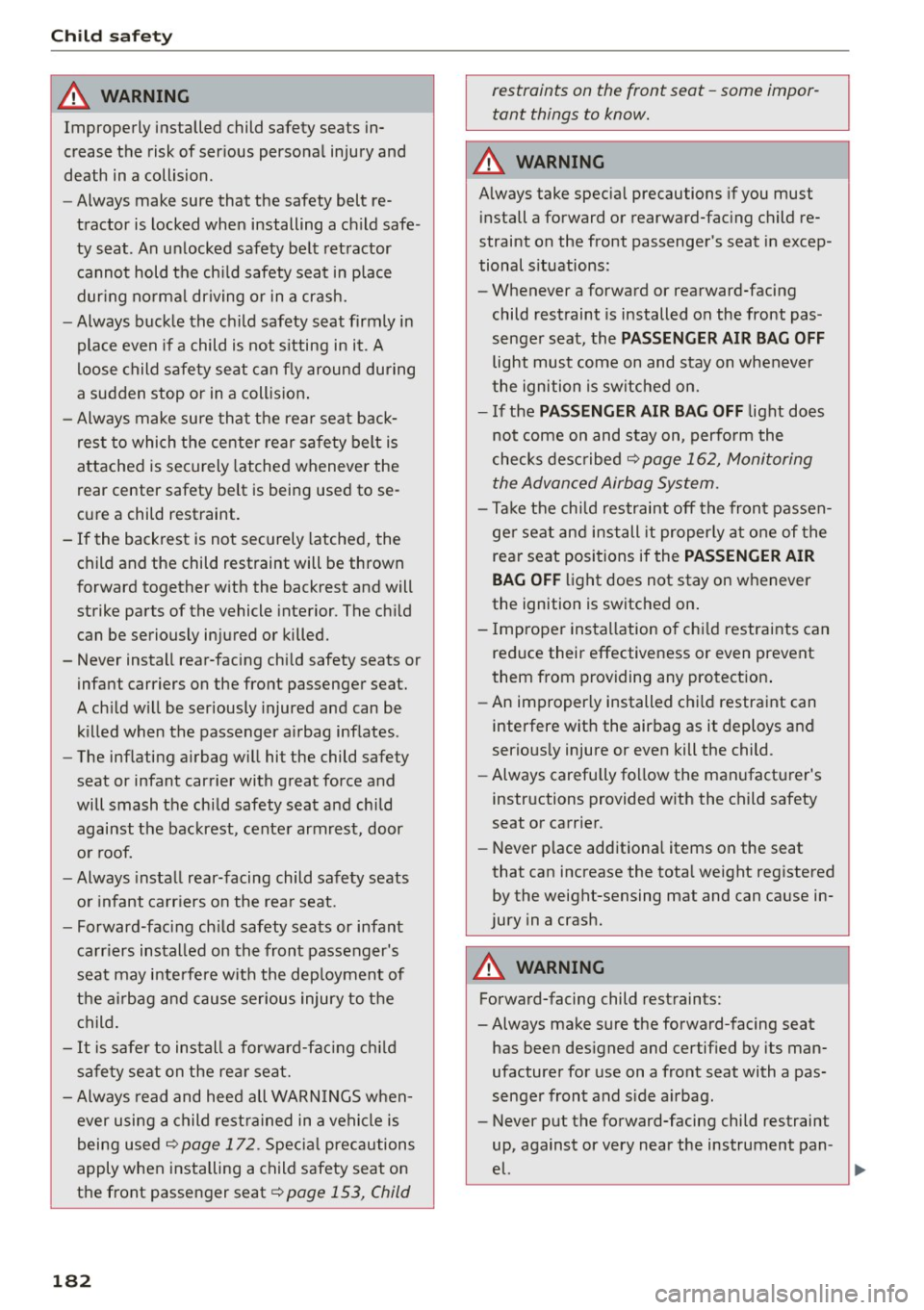
Child safety
A WARNING
Improperly installed child safety seats in
crease the risk of serious personal injury and
death in a collision.
- Always make sure that the safety belt re
tractor is locked when installing a child safe
ty seat . An unlocked safety belt retractor
cannot hold the child safety seat in place
during normal driving or in a crash.
- Always buckle the child safety seat firmly in
place even if a child is not sitting in it. A
loose child safety seat can fly around during
a sudden stop or in a collision.
- Always make sure that the rear seat back
rest to which the center rear safety belt is
attached is securely latched whenever the
rear center safety belt is being used to se
cure a child restraint.
- If the backrest is not securely latched, the
child and the child restraint will be thrown
forward together with the backrest and will
strike parts of the vehicle interior. The child
can be seriously injured or killed.
- Never install rear-facing child safety seats or
infant carriers on the front passenger seat.
A child will be seriously injured and can be
killed when the passenger airbag inflates .
- The inflating airbag will hit the child safety
seat or infant carrier with great force and
will smash the child safety seat and child
against the backrest, center armrest, door
or roof.
-Always install rear-facing child safety seats
or infant carriers on the rear seat.
- Forward-facing child safety seats or infant
carriers installed on the front passenger's
seat may interfere with the deployment of
the airbag and cause serious injury to the
child.
- It is safer to install a forward-facing child
safety seat on the rear seat.
- Always read and heed all WARNINGS when
ever using a child restrained in a vehicle is
being used
~page 172. Special precautions
apply when installing a child safety seat on
the front passenger seat~
page 153, Child
182
restraints on the front seat -some impor
tant things to know.
A WARNING
Always take special precautions if you must
install a forward or rearward-facing child re
straint on the front passenger's seat in excep
tional situations:
- Whenever a forward or rearward-facing
child restraint is installed on the front pas
senger seat, the
PASSENGER AIR BAG OFF
light must come on and stay on whenever
the ignition is switched on.
- If the PASSENGER AIR BAG OFF light does
not come on and stay on, perform the
checks described
~ page 162, Monitoring
the Advanced Airbag System.
-Take the child restraint off the front passen
ger seat and install it properly at one of the
rear seat positions if the
PASSENGER AIR
BAG OFF
light does not stay on whenever
the ignition is switched on.
- Improper installation of child restraints can
reduce their effectiveness or even prevent
them from providing any protection.
- An improperly installed child restraint can
interfere with the airbag as it deploys and
seriously injure or even kill the child .
- Always carefully follow the manufacturer's
instructions provided with the child safety
seat or carrier.
- Never place additional items on the seat
that can increase the total weight registered
by the weight-sensing mat and can cause in
jury in a crash.
A WARNING
Forward-facing child restraints:
-Always make sure the forward-facing seat
has been designed and certified by its man
ufacturer for use on a front seat with a pas
senger front and side airbag.
- Never put the forward-facing child restraint
up, against or very near the instrument pan
el.
-
.__ ________________ __J ...